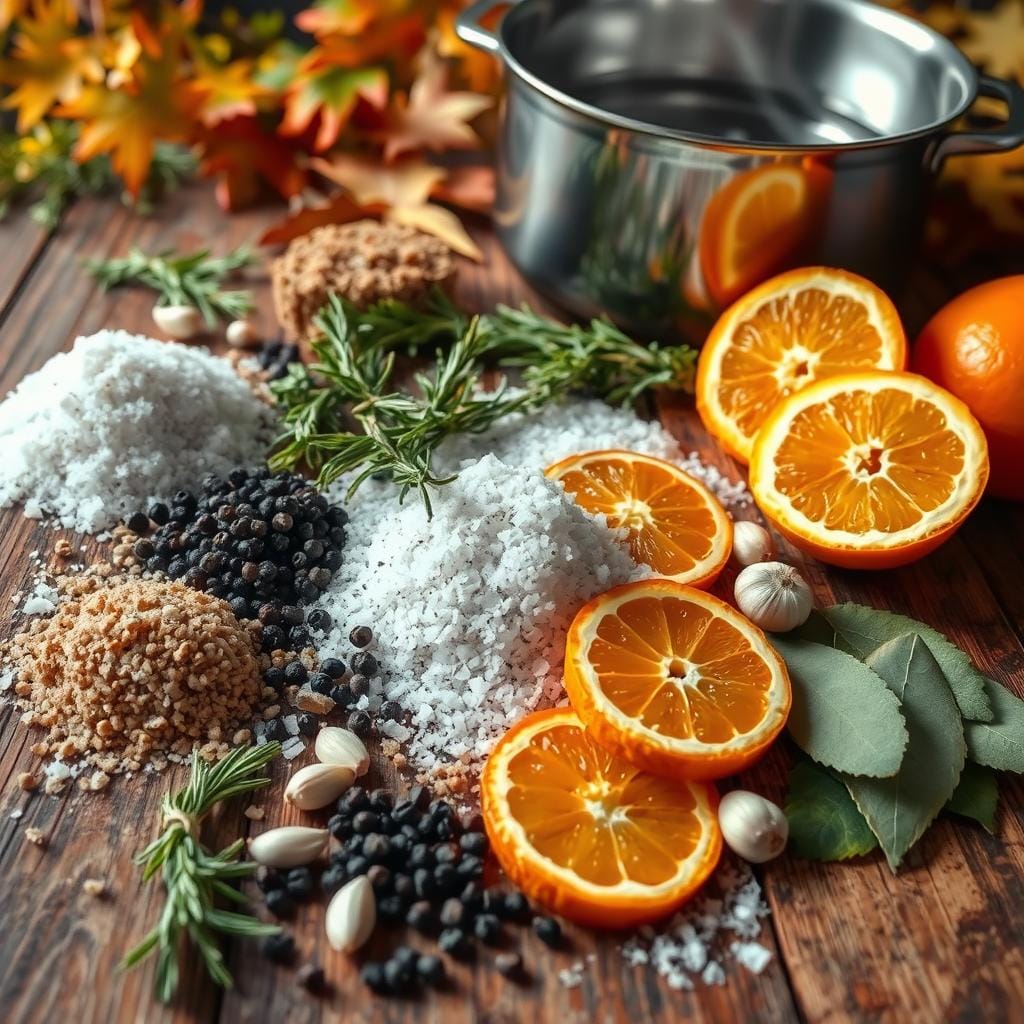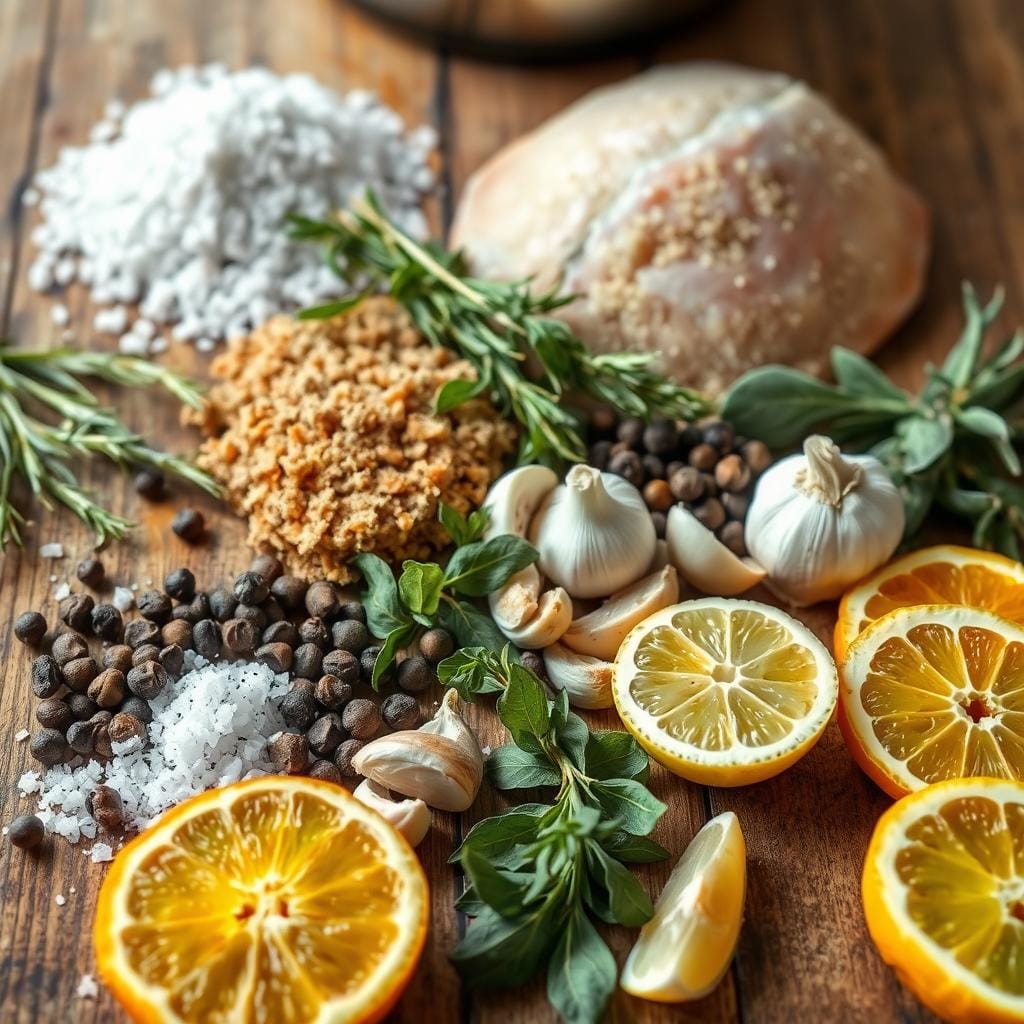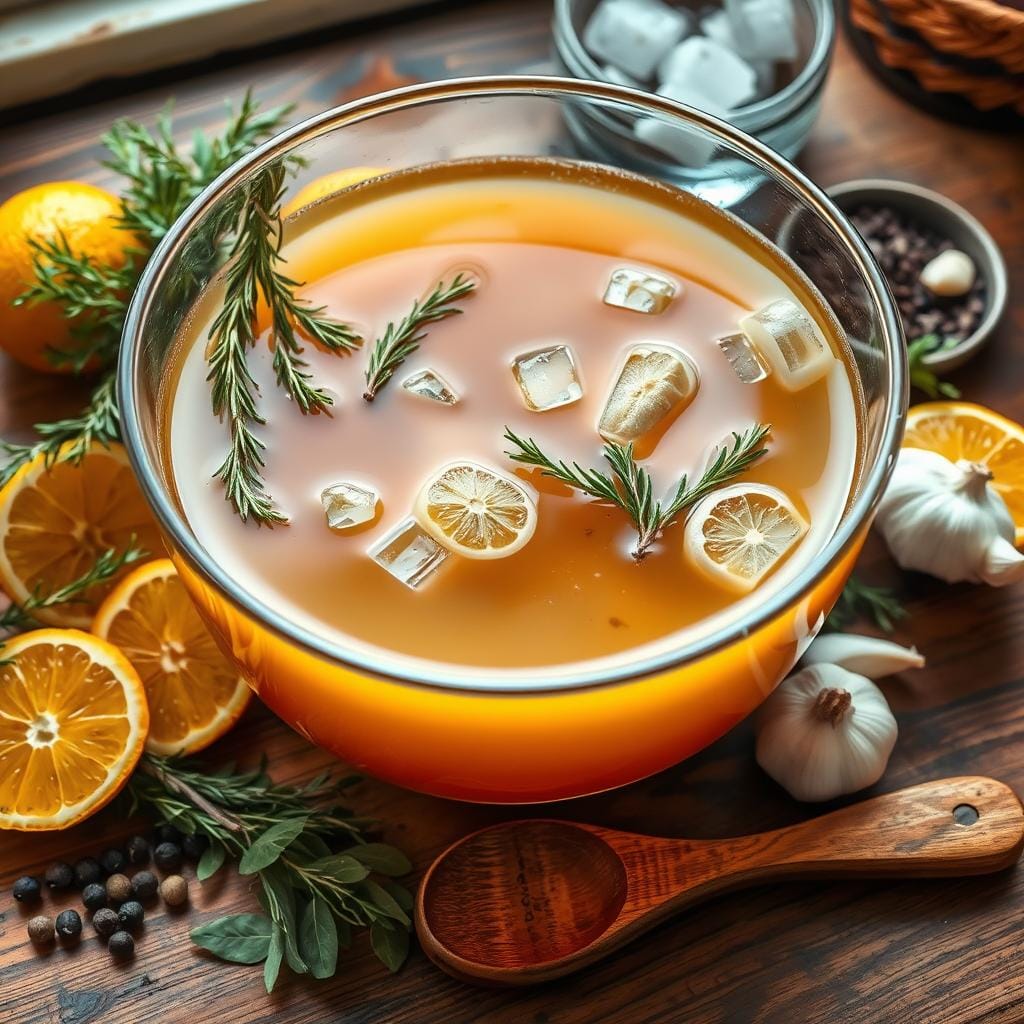The holiday season is the perfect time to gather around the table with loved ones and enjoy a delicious Thanksgiving turkey. But let’s face it: achieving a moist and flavorful bird can sometimes be a challenge. That’s where the perfect turkey brine recipe comes in—a simple yet transformative technique that ensures your turkey is juicy and packed with flavor every single time.
I remember the first time I brined a turkey. It was amazing. The meat went from dry to juicy and full of taste. It was like I had discovered a secret to making food extra special.
In this article, I’ll show you how to brine a turkey perfectly. You’ll learn the science behind it. This way, you can make the most delicious Thanksgiving turkey your family has ever had. Get ready to be the star of the holiday feast!
Key Takeaways
- Brining your turkey is the key to achieving a moist, flavorful bird
- The science of brining involves salt penetrating the meat and osmosis drawing in moisture
- This recipe provides the perfect balance of salt, aromatics, and seasonings for a truly exceptional turkey
- Proper brining techniques and equipment are essential for success
- Avoiding common brining mistakes will ensure your turkey turns out perfectly every time
Understanding the Science Behind Turkey Brining
Brining a turkey makes it juicy and flavorful. But why does it work so well? Let’s explore the science behind turkey brining and why it’s so effective.
How Salt Penetrates the Meat
Salt interacts with the turkey’s muscle fibers in a special way. When you soak the turkey in a saltwater brine, salt molecules move into the meat. This happens because of the concentration gradient, with salt moving from the brine into the meat.
The Role of Osmosis in Brining
Osmosis is key in brining. As salt gets into the turkey’s cells, it changes the osmotic balance. This draws water into the meat, making it juicier and more tender.
Benefits of Moisture Retention
The brine keeps the turkey moist during cooking. It breaks down muscle fibers, allowing them to hold more water. This prevents the turkey from drying out, even when it’s hot.
Knowing the science behind turkey brining helps you make a perfect, juicy bird. With this knowledge, you can make a brine solution that turns your Thanksgiving turkey into a delicious masterpiece.

| Benefit | Explanation |
|---|---|
| Increased Moisture Retention | The brine solution helps the turkey’s muscle fibers hold onto more water, preventing it from drying out during cooking. |
| Tenderization | The salt in the brine breaks down the turkey’s muscle fibers, making the meat more tender and juicy. |
| Enhanced Flavor | The brine solution allows the turkey to absorb a greater amount of seasonings and aromatics, resulting in a more flavorful bird. |
Essential Turkey Brine Recipe Ingredients
Making the perfect turkey brine starts with the right ingredients. The key components include salt, water, and sugar. You can also add herbs and spices for extra taste. Knowing how each ingredient works is crucial for a juicy, tasty bird.
The Salt Factor
Salt is the heart of a good turkey brine. It breaks down the meat’s proteins, keeping it moist while cooking. The best recipes use 1/2 cup of kosher or sea salt for every 1 gallon of water.
Sweetness and Aromatics
- Sugar: A bit of brown sugar or honey adds sweetness, balancing the salt and boosting flavor.
- Herbs and Spices: Thyme, rosemary, bay leaves, peppercorns, and citrus zest add a wonderful aroma and flavor.
Together, salt, sugar, and spices make a turkey brine ingredients that soak into the meat. This results in a juicier, more flavorful turkey.

“The secret to a perfectly moist and flavorful turkey is all in the brine. Follow this simple recipe, and you’ll be the talk of the Thanksgiving table!”
With the right ingredients and some prep, you’re set for a remarkable turkey. It will impress your guests.
Step-by-Step Guide to Preparing Your Brine Solution
Making the perfect easy turkey brine is about finding the right mix of ingredients. Whether you’re an experienced cook or hosting your first Thanksgiving, this guide will help. It shows you how to make a brine that turns your turkey into a juicy, delicious main dish.
Measuring and Combining Ingredients
To start your turkey brine seasoning, measure out the needed ingredients. First, figure out your turkey’s size. Then, use a trusted recipe to find the right salt, water, and seasonings.
- Measure the right amount of salt, sugar, or brining agents.
- Get the right amount of water, making sure it’s clean.
- Add herbs, spices, or citrus to the brine.
- Put all ingredients in a big, non-reactive container. Stir until everything dissolves.
Achieving the Perfect Salt-to-Water Ratio
The secret to a great turkey brine is the salt-to-water mix. Use about 1/2 cup of salt for every 1 gallon of water. But, the exact ratio can change based on your taste and turkey size.
Adding Aromatics and Seasonings
After getting the salt-to-water mix right, add your favorite aromatics and seasonings. Some favorites include:
- Freshly cracked black pepper
- Dried herbs like rosemary, thyme, or sage
- Citrus fruits like orange, lemon, or lime
- Garlic cloves, onions, or shallots
- Whole spices like peppercorns, allspice, or juniper berries
Don’t be afraid to try different flavors to find your perfect turkey brine seasoning.
Selecting and Preparing Your Turkey for Brining
Choosing the right turkey is key for brining a turkey and getting it juicy and flavorful. Start by picking a high-quality bird that’s good for brining. Make sure it’s fresh or thawed, and not already brined or injected with sodium.
After picking your turkey, prepare it for brining. First, thaw it if it’s frozen, following safe thawing steps. Then, take out the giblets and any other inside parts. This makes the turkey ready for the brine.
To make the turkey brine tips work best, dry the turkey with paper towels before brining. This helps the brine soak into the meat better. This makes the turkey juicier and more flavorful.
- Select a fresh or thawed turkey, avoiding pre-brined or injected birds.
- Thoroughly thaw the turkey if it’s frozen, following safe thawing guidelines.
- Remove the giblets and any other internal components.
- Pat the turkey dry with paper towels before placing it in the brine.
“The key to a perfectly brined turkey is in the preparation. Taking the time to select and ready your bird will ensure the brine works its magic, delivering a moist and flavorful feast.”
By following these steps, you’re ready for a great brining a turkey experience. You’ll get a delicious, juicy turkey as your reward.
Best Equipment and Containers for Brining Success
Choosing the right equipment and containers is key for a juicy, flavorful turkey. You need the perfect container size and to keep the turkey at the right temperature. These factors are crucial for a successful turkey brine.
Container Size Guidelines
The container size should match your turkey’s size. Use a container big enough to cover the turkey with a little extra room at the top. A good size is 2-3 gallons bigger than your turkey.
Storage Temperature Requirements
Keeping the turkey at the right temperature is important. The ideal brining temperature is between 38°F to 40°F. This cool temperature helps the turkey soak up the brine and prevents harmful bacteria. Make sure your brining container stays in the fridge or a cooler with ice.
Essential Brining Tools
- A large, non-reactive container (such as a food-grade plastic or stainless steel vessel)
- A heavy-duty resealable bag or brining bag
- A weighted plate or other object to keep the turkey submerged
- A thermometer to monitor the brine temperature
- A large spoon or whisk for stirring the brine
With the right tools and temperature control, you’re set for a juicy, flavorful turkey brine recipe and a brine solution for turkey that will wow your guests.
Optimal Brining Times and Temperature Guidelines
Brining your turkey is key to a moist and flavorful bird. But, timing and temperature are crucial. The turkey brine time depends on the turkey’s size. You want to find the right time for the meat to soak up the seasoning.
For a general guideline, brine your turkey overnight or for 12-24 hours. The size of your turkey determines the brining time. A 12-pound turkey needs 12 hours, while a 20-pound turkey might need up to 20 hours.
The best brining temperature is between 35-40°F. This cool range helps the turkey absorb flavors without becoming too salty. Brining at room temperature can cause bacterial growth and safety issues.
“Brining is the secret to the most tender, juicy, and flavorful turkey you’ll ever taste.”
If you can’t brine for the full time, brining overnight for 8-12 hours still works. This shorter time can still make your turkey delicious and moist.
Perfect turkey brining is about balancing time and temperature. With some planning and care, you’ll get a juicy, flavorful turkey. Your guests will love it.
Common Brining Mistakes to Avoid
Brining your turkey can make a big difference. But, it’s key to avoid common mistakes that can ruin the taste. Follow these tips to make sure your turkey is juicy and full of flavor, impressing everyone at the table.
Over-Brining Dangers
Brining adds moisture and flavor to your turkey. But, brining too long can make it too salty and soggy. Stick to the recommended brining time to get it just right.
Temperature Control Errors
Keeping the right temperature during brining is important. Too warm and bacteria can grow, too cold and it won’t soak in well. Make sure your brine is at the right temperature for the best results.
Salt Concentration Issues
The right amount of salt in your brine is crucial. Too little and it won’t work, too much and it’s too salty. Use trusted turkey brine tips to get the best turkey brine mix.
Avoid these common mistakes to get a delicious, moist turkey. Success in brining comes from paying attention to details and following the process carefully.
Tips for Enhancing Your Turkey Brine with Herbs and Spices
Adding herbs and spices to your turkey brine can make your Thanksgiving dinner unforgettable. The best turkey brine is more than just salt and water. It’s about blending flavors that make every bite delicious.
Think about the turkey brine seasoning that you like. Thyme, rosemary, and sage give a classic taste. But, chili powder, cumin, or smoked paprika add a bold twist. Mix fresh and dried herbs for the best flavor.
- Thyme: Adds an earthy, slightly minty note to the brine.
- Rosemary: Lends a fragrant, pine-like flavor that pairs beautifully with turkey.
- Sage: Provides a warm, slightly peppery taste that enhances the natural flavors of the bird.
- Garlic: Adds a savory, umami-rich dimension to the brine.
- Peppercorns: Contribute a subtle heat and depth of flavor.
Finding the right balance is key for a great turkey brine seasoning. Start with a little of each and adjust as needed. You want a mix that makes the turkey juicy and tender without being too strong.
“The perfect turkey brine is a delicate dance between salt, water, and a symphony of aromatic herbs and spices.”
Don’t be afraid to try new things. The best turkey brine for your Thanksgiving is waiting to be discovered.
Post-Brining Steps for the Perfect Roast
After brining your turkey, there are key steps to take for a perfect roast. These include drying, seasoning, and resting. These tips will make your turkey juicy and full of flavor.
Proper Drying Techniques
Before roasting, dry the turkey skin well. Use paper towels to remove excess moisture. This step helps the skin become crispy and golden.
Don’t rinse the turkey after brining. This can wash away the flavorful brine.
Seasoning After Brining
Even with brining, you can add more seasoning before roasting. Rub the turkey with melted butter or olive oil, and your favorite herbs and spices. This creates a delicious crust.
But don’t overdo it with the seasoning. The brine has already added a lot of flavor.
Resting Time Requirements
After roasting, let the turkey rest for 20-30 minutes before carving. This step makes the turkey juicier and more flavorful. Use this time to prepare your sides or make a tasty gravy.
| Step | Recommendation |
|---|---|
| Drying the Turkey | Thoroughly pat the turkey dry with paper towels to remove any excess moisture. |
| Seasoning After Brining | Rub the skin with a mixture of melted butter or olive oil, along with your favorite herbs and spices. |
| Resting Time | Let the turkey rest for at least 20-30 minutes before carving to allow the juices to redistribute. |
By following these steps, you’ll have a deliciously juicy and flavorful turkey. Your guests will love it. Enjoy every bite!
Conclusion
In this guide, you’ve discovered how to brine a turkey perfectly for Thanksgiving. By understanding brining science and using our easy turkey brine recipe, you’ll make a moist, flavorful turkey. It will impress your guests.
Brining your turkey changes the game. It keeps the meat moist and adds a tasty mix of seasonings. You can choose a classic brine or try herbs and spices. The right brine recipe will make your holiday meal unforgettable.
As you prepare for Thanksgiving, remember what you’ve learned here. Brining is an art that makes your turkey juicy and flavorful. Your family and friends will love every bite. You’ll be the star of the holiday table.

